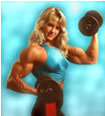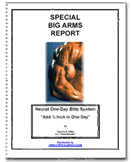
AUDIO/VISUAL
Visitor #
Since 3 Dec. '02
| A Revisit with the PHA System
By: Dennis B. Weis One of the most EFFECTIVE methods of weight training I have ever come across which creates a 'dual' force of SUPER HEALTH and STRENGTH is the PHA (Peripheral Heart Action) system that former Mr. America and Mr. Universe, Bob Gajda promoted back in the mid 1960's. It was during this time that Mr. Gajda was winning all of the top contests in competitive bodybuilding. Thus, it was not unusual to see many Iron Man magazine articles relating in detail about this seemingly successful training method. We are fast approaching 2009, and very little has been said in many years about this wonderful method of training. WHY? Because the PHA system represented a radical change from the established training methods of the day and seems to have followed on through up to the present time. Basically, most of the training methods that most bodybuilders employ revolve around the PUMP SYSTEM. The idea here is to pump blood into the muscle, causing the muscle to congest. Now as you begin to really force the repetitions out within a particular set, you will experience a burning sensation as the LACTIC ACID begins to build up. Finally, the muscle will begin to cramp and as a result of these pumping requirements, the muscle will finally reach the state of total exhaustion. It is here that the muscle needs quite a rest before you can go on and perform another set for that bodypart. It is this certain PUMPED feeling that a bodybuilder AIMS for in a set because it gives him the feeling that he is actually growing from the set. Is this mentioned system of pumping the most healthful and result producing for lasting bodybuilding gains? NO! Let's observe the steps that take place during a set where pumping is employed. Too much concentrated exercise directed toward a certain muscle at one time will cause retention or back up of the veinal blood supply within the muscle being exercised. Good examples of TOO much CONCENTRATED EXERCISE are principles like Super Sets, Tri Sets, and Giant Sets, etc. Continuing on, we find that the retention of the veinal blood supply will dam the return blood supply to the heart, causing the heart to strain abnormally. Right away there is going to be a high build up of toxins, and lactic acids from this type of training procedure. Now to compound this problem, we find that most bodybuilders using the above mentioned pump system will take longer rest periods between sets than necessary and this in turn SLOWS down circulation of the blood supply even further. At this point, I should mention that it is not a wise practice to hold the breath during heavy exertions. This practice will cause a rise in the overall blood pressure. Cardiac intake and output may be reduced by as much as 30 percent. So when performing heavy movements such as squats, deadlifts, etc., in which it is difficult to breathe, take in short, quick gasps of air between reps to build up a reservoir of oxygen in the blood. This is called hyper-ventilating. Breathing in just before the lift and begin breathing out approximately two-thirds (or near the sticking point of the lift) of the way through the movement. This practice will relieve intrathoracic or abdominal pressures. EXHALE fully when you reach the completed position. With lighter exercise movements, breathe rhythmically to the temp of the exercise. During a curl, for example inhale deeply prior to the start of the curl and exhale completely as the bar is lowered. This type of breathing technique sets the respiratory and cardiovascular system for the effort. Also, this deep breathing helps to remove all the impure air and toxins from the system. It would seem that from what has been mentioned thus far that a bodybuilder who is conscious of health and strength factors would immediately drop such a system as the one described above (which slows circulation of the blood and causes an abnormal rise of blood pressure) and adapt to a more healthful way of training. If you are serious about training for maximum results in health and strength, hee then is the way you should approach your training. THE IDEA IN TRAINING IS TO KEEP THE BLOOD CIRCULATING IN AND OUT OF THE MUSCLE AT ALL TIMES WHILE MAINTAINING A PULSE RATE OF 160-190 BEATS PER MINUTE. The PHA system is excellent for this purpose. As well, it will add to your training endeavors a good measure of strength and muscle size. Let's set up a system of PHA training. A big mistake most bodybuilders make when setting up a program is that they will think of the 11 major muscle groups as a whole without regard to the other muscles which make up that particular muscle group. For example, many bodybuilders will perform endless sets of squats or leg presses for the thighs and consider that as being sufficient for working the total thigh region. This is not the right attitude. You must take into consideration the quadriceps, thigh biceps, adductors (inner thighs), and the vastus internus (side of thigh). All of these areas will require some of your attention when planning out your training program from that muscle group. At this point, I'll break down the remaining muscle groups in the body so that you will have an idea of what we are talking about. Back: traps, upper lats, lower lats, and spinae erectors. Chest: upper pecs, lower pecs, and rib cage. Shoulders: anterior (front), lateral (side) posterior (rear) deltoids. Biceps: upper (for peak), lower. Forearms: flexors and extensors. Triceps: outer head, inner head, long head. Abdominals: rectus, lower and the obliques. Calf: tibileous. Neck: front and back. >From this we conclude that approximately 28 exercises are necessary to cover these various body-part areas. Pick out 28 movements that will benefit these body-parts. Divide these exercises up into sequences. You will pick approximately 6 exercises per sequence and 5 sequences. Now the six exercises in a sequence are to be for different body-parts. For example, a sequence might look like this: 1) Delts, 2) Thighs, 3) Waist, 4) Lats, 5) Biceps, 6) Calves. Your second sequence might cover: 1) Delts, 2) Thighs (perform a different exercise than you did in the 1st sequence), 3) Waist, 4) Chest, 5) Traps, 6) Calves. The sets and reps requirements for the exercise in the sequences should be as follows: Beginner:2 sets of 10 reps Some points to remember about PHA training: 1) Using the illustration of the sequence above, perform one set of exercises in No. 1, then go IMMEDIATELY to exercise No. 2 and so on till you have performed one set of each movement in the particular cycle. Now go back to exercise No. 1 and repeat the entire process for the number of sets required in the sequence with regard to whether you are a beginner or advanced bodybuilder, etc. 2) Do not proceed from one sequence till you have completed the required sets and reps in the manner described. 3) Generally, it is best to emphasize the deltoids, waist and calves in the various sequences. So here we begin with a delt movement first and about the middle of the sequence, place a waist exercise and the latter or final movement might be a calf exercise. 4) Many people will have quite a problem with labored breathing during these almost continuous exercise patterns. Here a heavy movement should be followed by a lighter movement. This will space your breathing out in a controlled manner (without much panting). This way your poundage’s and style won't suffer either. You'll still benefit from the continuous circulation movements. If you still suffer from labored breathing, insert a lot of breathing pullover type movements between some of the heavier exercises till it corrects itself. 5) Never work more than one exercise per body-part in the same sequence. An example of this wrong method would be two biceps movements or even a biceps and a direct triceps movement. This type of exercise selection would stop our effort of the continuous circulation that we are striving for. 6) When you are into training the total body 4 to 6 days per week, be sure that you place the intensity of the workout one day on the lower body while working the upper body with less intensity (but still within the guidelines of continuous circulation.) Reverse this method the following training day. 7) Arrange your exercise sequences so that you don't do all the POWER MOVEMENTS (Bench press, squats, and deadlifts) on the same workout day. Other items you should remember - Don't place two types of pressing movements in the same sequence. In other words, if you are working the delts and chest in the same sequence you might want to do some type of pressing for the chest and stick to laterals for the delts. Then in your next sequence reverse the procedure and perform pressing in its various forms for delts and work the chest with some flyes or 'crusher' type movements. Most concentrated forearm building exercises should be left till near the end of the UPPER BODY TRAINING in the last two sequences. If your grip is fatigued, then you will lose maximum efficiency, so remember this when setting up your program. Warm-ups are IMPORTANT also. The first set of each exercise in a sequence for the beginner should constitute the warm-up set. Use approximately 60 percent of your maximum for the required reps for this. Looking toward the intermediate and advanced man as many as 2 to 3 sets MAY be necessary. For this use 75 percent of maximum, but for only 1/2 the recommended reps before going to maximum on the remaining two to seven sets as the case may be. This system of PHA training is great because it promotes continuous circulation of blood and all the while the new blood brings in oxygen and buffers (phosphates) which help a great deal to neutralize the lactic acids and toxins. One thing you won't experience with PHA training is that feeling of being PUMPED and it is probably for this reason that the bodybuilder tends to avoid this most beneficial way of training. REMEMBER to ATTACK each set as if it were the last (after the warm-ups) one you were going to be performing for a particular exercise. The idea behind this article was not to go into an explicitly calculated PHA program, but to revisit this revolutionary training procedure as described in detail by Iron Man magazine by its most successful example, Robert Steven Gajda. |


